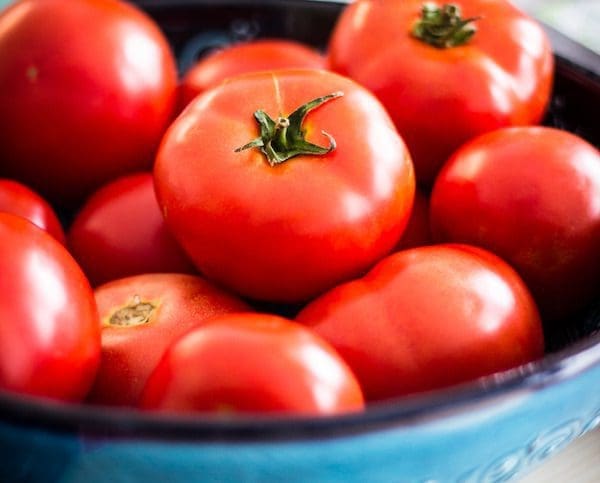When Hubby was first diagnosed, we asked the physicians what we could do in addition to treatment. One urologist said, “I heard lycopene is good for prostate cancer, and tomatoes have lycopene, so you might want to eat more tomatoes.”
“Good,” said Hubby out of earshot of the doctor. “I’ll add more tomatoes to my Big Macs and I’ll be just fine.”
Photo credit: Unsplash
We began reading up on nutrition—steering clear of the extremes—and came up with our own common sense diet. We increased our fruit and veggie intake; we ate more whole grains and legumes; we eliminated unhealthy fats and sugars; and we incorporated more seafood into our diet.
And then Hubby became a patient at the St. Charles Cancer Center and we met their registered dieticians. Who confirmed that what we were doing was the best option for his type and stage of cancer. These dieticians not only became friends, but were a wealth of knowledge.
Transitioning toward more healthful eating is a good idea whether you’re dealing with cancer or heart disease, or diabetes or obesity. Or none of the above. It’s just a good idea.
Here are 7 tips for eating better that worked for us. And the best part is, they’re all doable:
1. Don’t cut anything out of your diet. Yet. To begin with, concentrate on what you can add in. More fruits and veggies. Whole grains and legumes. Fats that are healthy for you, such as olive oil, avocados and nuts. After a while, you can begin eliminating the unhealthy foods. Because as you fall in love with veggies and fruits and whole grains, the old stuff you were eating won’t entice you nearly as much.
2. Eat a plant-based diet. Seventy-five per cent of your plate should be covered in plant foods. Use meat to enhance a recipe. Instead of serving each member of your dinner party a full chicken breast, for example, shred a smaller amount of cooked, seasoned chicken to be added to the pasta and veggie dish, or to the tortillas with plenty of vegetables to make a really great chicken soft taco.
3. Follow the 80/20 Rule. This is a favorite rule of the cancer center’s registered dietician. Eighty per cent of the time, try to eat healthfully. The other 20 per cent, have that pizza after your son’s basketball game, or that piece of cake at your sister’s wedding.
4. Eat natural foods. As much as possible, stay away from processed foods. Read the labels, our registered dietician friend is fond of saying. If your grandmother has never heard of the ingredients, they’re probably not good for you.
If your grandmother has never heard of the ingredients, they’re probably not good for you.
5. Eat organic if you can afford it. There is a list of the Dirty Dozen and Clean Fifteen foods at the Environmental Working Group website. If finances are an issue, then you could purchase organic produce from the Dirty Dozen list, and conventionally grown produce from the Clean Fifteen list. Bottom line, though, says the registered dietician, eating non-organic fruits and vegetables is better than eating no fruits and vegetables.
6. Implement portion control. I’m sure you’ve heard it said that we Americans eat portions of food that are unnecessarily large. If this is you, don’t.
7. Eat outdoors. You’re probably not going to find this one in any of your nutritional reading. But there’s gotta be some scientific evidence that eating outdoors is somehow healthier for you, right? If for no other reason than food tastes better outdoors. And I think God created food and taste buds and a sense of smell so we’ll enjoy eating. Not over-eating, mind you … but eating.
These are generic guidelines that worked for us for nine plus years. Always check with your doctor before trying any new diet because the differing types and stages of cancer may require different guidelines. When Hubby starting losing weight through muscle loss, for example, we needed to modify our diet to incorporate more protein. And later still, the dietician said he could eat anything he wanted, because he needed calories.
When Niece Heidi was visiting last week, we made a chicken salad. She sliced and diced all the fruits and vegetables we could find in the fridge while I sautéed a small amount of boneless, skinless chicken breast.
Romaine and butter lettuce. Cucumbers and carrots. Mushrooms. Olives. Thin apple slices. Juicy orange pieces. Broccoli. Avocados. Toasted pecans. The only thing missing was feta cheese.
We built individual salads in the kitchen, and then ate outdoors on the patio. And it was a fabulous blend of the sweet and salty, the soft and crunchy.
Eating outdoors. Experimenting with all the fruits and veggies that were in the fridge. Following the 80/20 Rule with a plant-rich, natural and partially organic dish. We followed all seven tips listed above.
Well … maybe not #6. Portion control is hard to do when you’re building your own salad. You start small. But it happens every time. You end up with a mountain of a salad.
So six out of seven isn’t bad, right?




Leave a Reply